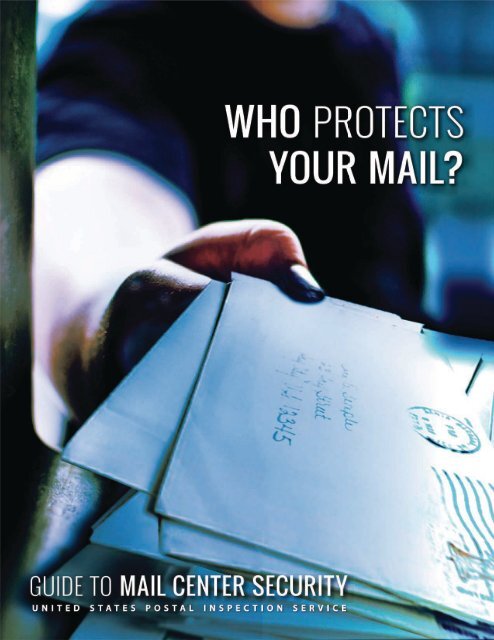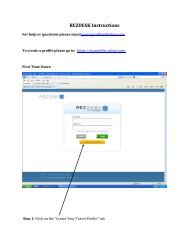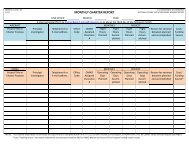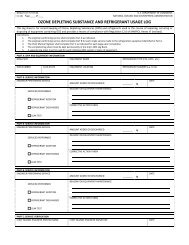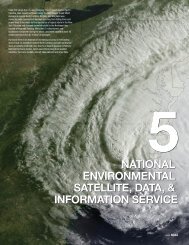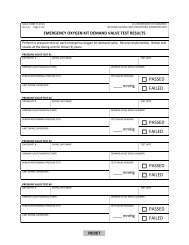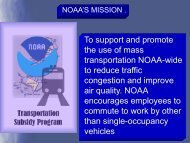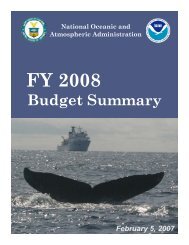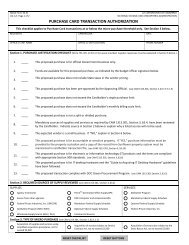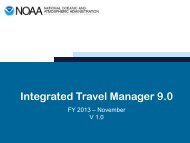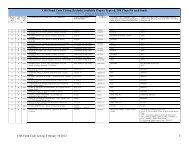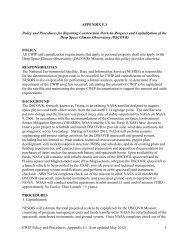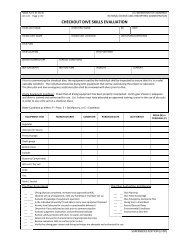Publication 166 - Guide to Mail Center Security - USPS.com
Publication 166 - Guide to Mail Center Security - USPS.com
Publication 166 - Guide to Mail Center Security - USPS.com
Create successful ePaper yourself
Turn your PDF publications into a flip-book with our unique Google optimized e-Paper software.
WHO PROTECTS YOUR MAIL?
guide <strong>to</strong> mail center security 3<br />
GUIDE TO MAIL CENTER SECURITY<br />
YOUR RISK LEVEL<br />
PHYSICAL SECURITY OF YOUR WORKPLACE<br />
3a<br />
YOUR MAIL CENTER 8<br />
EMPLOYEE ROLES AND RESPONSIBILITIES a<br />
MAIL THEFT 11<br />
SECURING YOUR MAIL CENTER FROM THEFT a<br />
LETTER OR PACKAGE BOMBS AND BOMB THREATS 13<br />
ESTABLISH A SECURITY AND BOMB-SCREENING PLAN<br />
CHEMICAL, BIOLOGICAL, OR RADIOLOGICAL THREATS 21<br />
SECURING YOUR MAIL CENTER FROM HAZARDOUS SUBSTANCES<br />
REFERENCES 25<br />
CHECKLISTS AND ADDITIONAL RESOURCES
WHO PROTECTS YOUR MAIL?
We Do! We’re the U.S. Postal Inspection Service<br />
The U.S. Postal Inspection Service is one of the Postal Service’s<br />
best-kept secrets. Many cus<strong>to</strong>mers aren’t even aware of what<br />
we do. So we want <strong>to</strong> take you behind the scenes and tell you<br />
how we can help you protect your business by securing your<br />
mail center.<br />
What we do is truly unique. As a federal law enforcement<br />
agency with more than 200 years of experience, our U.S. Postal<br />
Inspec<strong>to</strong>rs investigate every aspect of mail-related crime—<br />
including mail theft, mail fraud, and mail containing dangerous<br />
items or substances. The work we do, every day, assures<br />
millions of postal cus<strong>to</strong>mers they can depend on the security,<br />
privacy, and reliability of U.S. <strong>Mail</strong>. The U.S. Postal Inspection<br />
Service adds a value no other mail service can provide.<br />
guide <strong>to</strong> mail center security 1<br />
your risk level your mail center mail theft bombs & threats suspicious substances resources
u.s. postal inspection service<br />
Call a Postal Inspec<strong>to</strong>r near you!<br />
877-876-2455 (press 5)<br />
postalinspec<strong>to</strong>rs.uspis.gov<br />
Working Globally<br />
Postal Inspec<strong>to</strong>rs travel the world <strong>to</strong> train foreign postal<br />
administrations in the latest safety pro<strong>to</strong>cols, educating them in<br />
emergency responses <strong>to</strong> ensure readiness for all hazards. Longknown<br />
as experts in all matters related <strong>to</strong> mail security, our Chief<br />
Postal Inspec<strong>to</strong>r was made chairman of the Universal Postal<br />
Union’s Postal <strong>Security</strong> Group, directing Postal Inspec<strong>to</strong>rs <strong>to</strong><br />
extend their reach beyond U.S. borders <strong>to</strong> secure the international<br />
mail network—and ensure the safety of American citizens.<br />
Working for You<br />
Every business has different needs. This guide provides general<br />
re<strong>com</strong>mendations from Postal Inspec<strong>to</strong>rs <strong>to</strong> cover a broad range<br />
of businesses. Invite a Postal Inspec<strong>to</strong>r <strong>to</strong> visit your business and<br />
review your mail center operations. Their security reviews can<br />
pinpoint problems that could lead <strong>to</strong> mail theft or open the door<br />
<strong>to</strong> other security issues. You can ask an Inspec<strong>to</strong>r <strong>to</strong> schedule<br />
a workshop for your mail center employees <strong>to</strong> educate them<br />
on how <strong>to</strong> handle suspicious mail and deliver tips <strong>to</strong> improve<br />
security for your business and your employees.<br />
Thanks <strong>to</strong> us, the U.S. Postal Service® delivers the nation’s mail<br />
more safely and more securely than any other country in the<br />
world. And it’s all included in the price of postage.<br />
SECURITY: IT COMES WITH THE STAMP ®
YOUR RISK LEVEL<br />
guide <strong>to</strong> mail center security 3<br />
You can ensure safe mail handling standards for your organization by<br />
conducting a risk assessment of your mail operations. The assessment<br />
should focus on the room or area where mail is handled, its physical<br />
location, and its accessibility <strong>to</strong> employees and the public.<br />
your risk level<br />
<strong>Mail</strong>rooms may have a low, medium, or high risk level depending on<br />
their locations and their cus<strong>to</strong>mers. If your organization employs security<br />
professionals, they can identify your mailroom risks and re<strong>com</strong>mend<br />
how <strong>to</strong> address them. If not, you can immediately set in place some<br />
security measures; other measures will require some planning, action,<br />
and financing.<br />
Start your risk assessment by evaluating these areas:<br />
▼▼Location of mail operations.<br />
▼▼Jobs and tasks involved in processing mail.<br />
▼▼Personnel who handle the mail.<br />
▼▼Your cus<strong>to</strong>mers.<br />
Consider the nature of your business. If your organization could attract<br />
political or potentially controversial attention, it could be a target for a<br />
mailed threat. Your mail center may be situated within a high-risk facility<br />
or in a high-risk area of your <strong>com</strong>munity. It’s also important <strong>to</strong> be aware<br />
of your cus<strong>to</strong>mers and the types of business they conduct. International<br />
businesses or controversial professions or services can significantly<br />
heighten risks. By assessing the people who use your mailroom, you can<br />
determine the appropriate security level you need <strong>to</strong> maintain for it.<br />
Your assessment should identify the jobs, tasks, and personnel most likely<br />
<strong>to</strong> be jeopardized if a suspicious or dangerous letter or package entered the<br />
workplace. Postal Inspec<strong>to</strong>rs advise you <strong>to</strong> develop screening procedures<br />
for all in<strong>com</strong>ing deliveries, including those from private delivery firms, such<br />
as FedEx and UPS. All employees must be trained in safe mail handling<br />
procedures and should understand the importance of following pro<strong>to</strong>cols.<br />
In any case, it’s important that you’re familiar with your local and state<br />
emergency response capabilities.
u.s. postal inspection service<br />
When <strong>Mail</strong> is Federally Protected<br />
<strong>Mail</strong> received in<strong>to</strong> the hands of an addressee or addressee’s<br />
agent is considered properly delivered mail. <strong>Mail</strong> addressed <strong>to</strong><br />
employees or officials of an organization at the organization’s<br />
address is considered properly delivered after it’s received at<br />
the organization. For this reason, the Postal Inspection Service<br />
discourages staff from using their employer’s address <strong>to</strong> receive<br />
personal mail.<br />
<strong>Mail</strong> delivered in<strong>to</strong> a privately owned receptacle, designated by<br />
postal regulations as a deposi<strong>to</strong>ry for receipt or delivery of mail,<br />
is protected as long as the mail remains in the box. <strong>Mail</strong> adjacent<br />
<strong>to</strong> such a box is also protected.<br />
Protection for your mail ends when items are removed by the<br />
addressee or the addressee’s agent. <strong>Mail</strong> addressed <strong>to</strong> a Post<br />
Office box is considered delivered once it is properly removed<br />
from the box.<br />
Centralizing Your <strong>Mail</strong> Handling Operations<br />
One of the best ways <strong>to</strong> minimize risk <strong>to</strong> your employees<br />
and the public, reduce costs, and increase the efficiency and<br />
effectiveness of your mail center is <strong>to</strong> centralize mail handling at<br />
a separate location from the rest of your organization.<br />
Having a separate mail location reduces risk by limiting exposure<br />
<strong>to</strong> potentially dangerous mail <strong>to</strong> one location and fewer people.<br />
It also reduces costs by eliminating redundancies in locations,<br />
staff, and equipment. Establishing a trained staff <strong>to</strong> work at a<br />
single location increases the efficiency of your operations.
guide <strong>to</strong> mail center security 5<br />
your risk level<br />
Enhancing the Physical Layout of Your <strong>Mail</strong> <strong>Center</strong><br />
Properly designing a physical layout for your mail center is in<br />
itself a preventive security measure.<br />
tips for the l ayout of your mailroom<br />
▼▼Make all work areas visible <strong>to</strong> supervisors.<br />
▼▼Use one-way glass, closed-circuit video surveillance<br />
cameras, or elevated supervisor stations.<br />
▼▼Eliminate desk drawers and similar places of concealment.<br />
▼▼Ensure adequate supervision of mail center staff, who may<br />
have access <strong>to</strong> thousands of dollars worth of merchandise,<br />
remittances, and <strong>com</strong>pany credit cards.<br />
▼▼Control access <strong>to</strong> your mail center and handling areas.<br />
Use of sign-in/out sheets, card key access-control systems,<br />
and pho<strong>to</strong> ID badges are all effective security procedures.<br />
Extend this control <strong>to</strong> all employees, including cleaning<br />
and maintenance staff.<br />
▼▼Enforce limited access <strong>to</strong> your mail center. Only authorized<br />
employees should be allowed in the working areas of your<br />
mail center.<br />
▼▼Use a counter or desk <strong>to</strong> separate the area where<br />
employees pick up mail from the rest of the mail center.<br />
When developing policies and<br />
procedures for your mailroom,<br />
the key word is “prevention.”
u.s. postal inspection service<br />
This is a general guide <strong>to</strong> help you establish sound security pro<strong>to</strong>cols for your business.<br />
CHECKLIST FOR MAIL CENTER SECURITY<br />
Screen mail center personnel.<br />
Clearly label authorized receptacles for U.S. <strong>Mail</strong>.<br />
Ensure that mailroom location, furniture, and mail flow provide maximum security.<br />
Install alarms and surveillance equipment.<br />
Limit mailroom access <strong>to</strong> authorized personnel.<br />
Eliminate mail distribution delays.<br />
Protect postage and meters from theft or unauthorized use.<br />
Lock high-value items overnight.<br />
Verify and secure accountable items.<br />
Maintain control of address labels.<br />
Securely fasten labels <strong>to</strong> mail items.<br />
Check that postage meter strips do not overlap labels.<br />
Ensure that labels and car<strong>to</strong>ns do not identify valuable contents.<br />
Include a return address, and duplicate the return address label inside mailed items.<br />
Ensure presort and ZIP+4 ® savings are taken when applicable.<br />
Prepare parcels <strong>to</strong> withstand transit.<br />
Use containers and sacks when possible.<br />
Do not leave mail in an unsecured area, and deliver outgoing mail directly <strong>to</strong><br />
Postal Service cus<strong>to</strong>dy.<br />
Separate employee parking from mail delivery area.<br />
Immediately report lost or rifled mail <strong>to</strong> Postal Inspec<strong>to</strong>rs.<br />
Ensure supervisors can see all employees and work areas.<br />
Screen contrac<strong>to</strong>rs who provide delivery services.<br />
Eliminate any unnecessary s<strong>to</strong>ps by your delivery vehicles.<br />
Establish procedures for handling unexplained or suspicious letters and packages.<br />
Periodically test mail for loss and for quality control.<br />
Verify Postal Service receipts for meter settings against authorized amounts<br />
Regularly check postage meters.
guide <strong>to</strong> mail center security 7<br />
your risk level<br />
Enhancing the Physical <strong>Security</strong> of Your Workplace<br />
These guidelines will help ensure you offer a safe work<br />
environment for your employees.<br />
▼▼If your workplace has access control, don’t allow<br />
employees <strong>to</strong> gain entrance by “piggy backing” their way<br />
in behind others.<br />
▼▼Have security guards greet all visi<strong>to</strong>rs and examine<br />
personal belongings brought in<strong>to</strong> the building or office area.<br />
▼▼Restrict access <strong>to</strong> your workplace through locked or<br />
guarded entryways.<br />
▼▼Keep s<strong>to</strong>rage rooms, boiler rooms, telephone and utility<br />
closets, and similar potential hiding places locked or<br />
off-limits <strong>to</strong> visi<strong>to</strong>rs.<br />
▼▼Use distinct and separate ID badges for staff and visi<strong>to</strong>rs.<br />
▼▼Require visi<strong>to</strong>rs <strong>to</strong> be ac<strong>com</strong>panied by staff employees<br />
<strong>to</strong> and from the office or facility entrance.<br />
▼▼Request visi<strong>to</strong>rs <strong>to</strong> display IDs <strong>to</strong> security personnel<br />
when they sign in.<br />
▼▼Keep logs on the arrival and departure times of all visi<strong>to</strong>rs.<br />
▼▼Consider hiring a certified protection professional<br />
<strong>to</strong> evaluate your <strong>com</strong>pany’s personnel and physical<br />
security safeguards.
u.s. postal inspection service<br />
YOUR MAIL CENTER<br />
Appoint a <strong>Mail</strong> <strong>Center</strong> <strong>Security</strong> Coordina<strong>to</strong>r<br />
Postal Inspec<strong>to</strong>rs re<strong>com</strong>mend you appoint a mail center security<br />
coordina<strong>to</strong>r <strong>to</strong> oversee operations, ensure that security pro<strong>to</strong>cols<br />
are followed, and assure accountability for your mail.<br />
MAIL CENTER SECURITY COORDINATOR ROLES & RESPONSIBILITIES<br />
ROLE<br />
OVERSIGHT AND TRAINING<br />
RESPONSIBILITY<br />
• Oversees screening process<br />
and ensures all deliveries are<br />
channeled through the mail center.<br />
• Trains employees in detecting<br />
suspicious letters and packages,<br />
verifications, safe handling, and<br />
<strong>com</strong>munications with security<br />
and management in any crisis.<br />
COMMAND<br />
• Assumes <strong>com</strong>mand of the<br />
situation when a suspicious letter<br />
or package is identified by mail<br />
center employees during the<br />
screening process.<br />
SAFETY ENFORCEMENT<br />
• Ensures that personnel who<br />
detect suspicious mail place a<br />
safe distance between themselves<br />
and the item and that employees<br />
don’t cluster around the item.<br />
• Ensures that only mail center<br />
employees have access <strong>to</strong> the mail.
guide <strong>to</strong> mail center security 9<br />
YOU SHOULD CONSIDER THESE AREAS OF CONCERN:<br />
HOW EXTENSIVE IS YOUR PRE-EMPLOYMENT SCREENING?<br />
When you conduct pre-employment screening, check the job<br />
candidate’s criminal records, have him/her undergo a drug-screening<br />
test, perform a credit inquiry on him/her, and verify his/her former<br />
employment. When you interview a job candidate in depth and at<br />
length, you may identify potentially deroga<strong>to</strong>ry information.<br />
your mail center<br />
WHAT MAY PROMPT AN EMPLOYEE TO STEAL?<br />
Employees’ personal situations can change quickly. An honest,<br />
trusted employee can be<strong>com</strong>e a thief because of need. Alcohol,<br />
drugs, gambling, and marital or health problems can cause an<br />
employee <strong>to</strong> be<strong>com</strong>e dishonest. <strong>Mail</strong> center supervisors must be<br />
alert for personality changes that could signal problems. Take<br />
precautions <strong>to</strong> protect your <strong>com</strong>pany from theft: Reducing the<br />
opportunity <strong>to</strong> steal is an essential prevention technique.<br />
WHO SHOULD ACCEPT AND DROP OFF MAIL AND OTHER VALUABLES?<br />
Only authorized employees should be assigned <strong>to</strong> accept mail<br />
at the office. Give your local Post Office a list of authorized<br />
employees <strong>to</strong> keep on file. If staff changes, update the list<br />
immediately and inform the Post Office <strong>to</strong> avoid unauthorized staff<br />
from receiving mail. It’s crucial <strong>to</strong> keep the list current, especially<br />
when you process accountable mail, such as registered and<br />
certified letters.<br />
If your <strong>com</strong>pany sends out or receives valuables, vary the time<br />
of day and direction of travel between your office and the Post<br />
Office. Check periodically <strong>to</strong> determine if your mail couriers<br />
are making unauthorized s<strong>to</strong>ps or leaving mail unattended in<br />
unlocked delivery vehicles.
u.s. postal inspection service<br />
Train Your <strong>Mail</strong> <strong>Center</strong> Staff<br />
Education in and knowledge of security pro<strong>to</strong>cols are essential<br />
<strong>to</strong> preparedness. <strong>Mail</strong>room employees must be aware of their<br />
surroundings and the mail they handle. Carefully design and vigorously<br />
moni<strong>to</strong>r your security program <strong>to</strong> reduce risks for your organization.<br />
Training mailroom employees encourages a culture of security<br />
awareness in your operation. Your training program should<br />
address these concerns:<br />
▼▼Basic security procedures.<br />
▼▼Recognition and reporting of suspicious letters or<br />
packages.<br />
▼▼Proper use of personal-protection equipment.<br />
▼▼Response pro<strong>to</strong>cols for a chemical, biological,<br />
radiological, or bomb threat.<br />
Document training and regularly follow it up with refresher<br />
training. Consider using simulation exercises followed by in-depth<br />
reviews of response activities. Note areas where employees<br />
need improvement.<br />
All employees in your organization should understand your mail<br />
security procedures. This helps instill employee confidence in<br />
the safety of the letters or packages delivered <strong>to</strong> their desks.
guide <strong>to</strong> mail center security 11<br />
MAIL THEFT<br />
While you should properly address chemical, biological, and radiological<br />
threats, mail centers are much more likely <strong>to</strong> experience problems<br />
caused by <strong>com</strong>mon crimes such as theft. <strong>Security</strong> is vital <strong>to</strong> mail center<br />
operations large and small.<br />
Lack of security can result in theft of supplies, postage, mail, and any<br />
valuable information about your <strong>com</strong>pany contained in sensitive mail.<br />
To make your mail center secure and <strong>to</strong> reduce risks and losses, your<br />
<strong>com</strong>pany should have policies and procedures for the following:<br />
▼▼Personnel security.<br />
▼▼Access control.<br />
▼▼Registered <strong>Mail</strong> and high-value shipments.<br />
▼▼Company funds.<br />
▼▼Postage meters.<br />
mail theft<br />
Losses are charted by the Postal Inspection Service <strong>to</strong> identify<br />
problem areas and assist Inspec<strong>to</strong>rs in tracking down thieves.<br />
Report suspected mail losses <strong>to</strong> Postal Inspec<strong>to</strong>rs by calling<br />
877-876-2455 (press 3) or at postalinspec<strong>to</strong>rs.uspis.gov.
u.s. postal inspection service<br />
PREVENTING THEFT IN YOUR MAIL CENTER<br />
Keep Registered <strong>Mail</strong> separate from other mail.<br />
REGISTERED<br />
MAIL<br />
PETTY CASH<br />
POSTAGE<br />
METER<br />
SECURITY<br />
ADVANCE<br />
DEPOSITS<br />
USE OF<br />
AUTHORIZED<br />
DEPOSITORIES<br />
OUTGOING<br />
MAIL<br />
OUTSIDE MAIL<br />
PREPARATION<br />
SERVICES<br />
INCOMING<br />
MAIL<br />
MISSENT MAIL<br />
Require employees <strong>to</strong> sign for Registered <strong>Mail</strong> <strong>to</strong> establish accountability. Use a<br />
log <strong>to</strong> track Certified <strong>Mail</strong> ® and Registered <strong>Mail</strong> <strong>to</strong> record the date it’s received, the<br />
type of mail, and the Postal Service’s control number. The person receiving the mail<br />
must sign and date the log. This provides a reliable tracking system.<br />
Establish adequate controls <strong>to</strong> identify responsibility for losses that may occur.<br />
Never keep postage stamps in unlocked drawers.<br />
Restrict access <strong>to</strong> postage meters <strong>to</strong> authorized personnel. Do not allow employees<br />
<strong>to</strong> run personal mail through postage meters as it can result in theft of <strong>com</strong>pany<br />
funds. You can get an accurate account of postage and its purpose when only<br />
authorized employees operate postage meters.<br />
Keep your postage meter locked when not in use. Have a trusted employee<br />
maintain a record of meter register readings. This helps detect unauthorized, afterhours<br />
use of the meter and helps you obtain a refund if your meter malfunctions.<br />
Avoid paying for business reply, postage due, or other postal costs from petty<br />
cash. A petty cash drawer can provide a theft opportunity for dishonest mail center<br />
employees. Set up an advance-deposit account with your Post Office. Companies<br />
that prefer using petty cash can protect themselves against theft by requiring<br />
receipts from the Post Office for postage paid and by checking mail <strong>to</strong> ensure it<br />
balances with receipts.<br />
Don’t leave trays or sacks of mail on a curb next <strong>to</strong> a full collection box. If this is<br />
a problem, contact your postmaster <strong>to</strong> resolve. This could prevent your mail from<br />
being lost or s<strong>to</strong>len.<br />
Periodically <strong>com</strong>pare outgoing mail against cus<strong>to</strong>mer order lists. This can detect<br />
dishonest employees using their name and address for orders shipped <strong>to</strong> legitimate<br />
cus<strong>to</strong>mers. This is a difficult crime <strong>to</strong> detect unless someone reviews outgoing mail.<br />
When checking outgoing mail, see if employees are using metered postage for<br />
personal mail.<br />
Postal Inspec<strong>to</strong>rs have found some mail preparation service staff pocket fees<br />
without entering the material in<strong>to</strong> the mail or have grossly overcharged advertisers<br />
for postage. Your local Post Office’s Business <strong>Mail</strong> Entry Unit uses the PS Form<br />
3600 series <strong>to</strong> maintain a record of bulk mailings. Any questions related <strong>to</strong> quantity,<br />
costs, and the date of a mailing can be verified by contacting this unit.<br />
Clearly label deposi<strong>to</strong>ries used <strong>to</strong> receive in<strong>com</strong>ing mail and outgoing mail. Use PS<br />
Label 33, Report <strong>Mail</strong> Theft, Tampering, or Vandalism of this <strong>Mail</strong>box (see a sample<br />
on page 11), available from your local Post Office or the Postal Inspection Service,<br />
<strong>to</strong> alert employees that material in such receptacles is protected by federal law.<br />
Have a system <strong>to</strong> handle misdelivered or missent mail. Immediately return all such<br />
mail <strong>to</strong> the Post Office.
guide <strong>to</strong> mail center security 13<br />
LETTER OR PACKAGE BOMBS<br />
AND BOMB THREATS<br />
How vulnerable is your workplace <strong>to</strong> a bomb threat?<br />
The chance that your workplace will receive a letter or package<br />
bomb is extremely remote. The chances are greater of receiving<br />
a telephoned bomb threat or finding a suspicious and potentially<br />
harmful bomb placed at your workplace or on your property.<br />
What motivates people <strong>to</strong> send letter or package bombs? People<br />
often think of a mail bomber as a person motivated by radical political<br />
beliefs. This stereotype is incorrect. If you adhere <strong>to</strong> this stereotype,<br />
you may improperly assess and respond <strong>to</strong> a bomb threat.<br />
Jilted spouses or lovers may seek revenge at the end of their<br />
romantic involvement. Former business partners or employees<br />
may seek revenge when a business relationship goes sour or<br />
when business reversals cause layoffs or firings. Law enforcement<br />
officers and members of the judiciary have been targeted for bombs<br />
and bomb threats by individuals seeking revenge for having been<br />
investigated or prosecuted.<br />
Letter or package bombs usually target specific individuals. Placed<br />
devices, however, are generally intended <strong>to</strong> disrupt workplaces and<br />
injure indiscriminately. Bomb threats may target either individuals<br />
or organizations.<br />
bombs & threats<br />
Bombs can be designed for mailing in<br />
many shapes and sizes—not just packages.<br />
Even letter-size mail or flats can contain<br />
dangerous substances.
u.s. postal inspection service<br />
Revenge is the motivation<br />
that most often triggers<br />
a letter or package bomb,<br />
or a bomb threat.<br />
Identifying the Right <strong>Security</strong> Plan<br />
Your vulnerability and that of your workplace depends on many<br />
fac<strong>to</strong>rs, both internal and external. No individual or <strong>com</strong>pany is<br />
<strong>com</strong>pletely immune from attack. Your security officer and <strong>to</strong>p<br />
managers should meet <strong>to</strong> evaluate the probability that your<br />
<strong>com</strong>pany or its personnel be<strong>com</strong>e targets for mailed bombs and<br />
bomb threats.<br />
Postal Inspec<strong>to</strong>rs re<strong>com</strong>mend you consult with security experts<br />
about terrorist tactics and <strong>to</strong> receive a vulnerability assessment. The<br />
Postal Inspection Service can guide you in establishing a secure<br />
mail center and detecting letter and package bombs. Call a Postal<br />
Inspec<strong>to</strong>r near your workplace. The Bureau of Alcohol, Tobacco,<br />
Firearms and Explosives (ATF) has additional information on bomb<br />
threats and physical security planning at atf.gov.<br />
Since most explosive devices are placed, not mailed, your security<br />
plan must include controls over individuals who can physically access<br />
and move about your workplace and its immediate surroundings.<br />
These controls can reduce your <strong>com</strong>pany’s risk.<br />
Ask the questions shown on the next page during your assessment<br />
<strong>to</strong> develop information that will help identify <strong>com</strong>pany officers or<br />
employees who could be targeted or organizations that may attempt<br />
a bombing.
guide <strong>to</strong> mail center security 15<br />
FOREIGN TERRORISM<br />
▼▼Does your <strong>com</strong>pany have foreign officers, suppliers, or<br />
outlets? If so, in what countries? Are you doing business in<br />
countries where there is political unrest and civil strife, or<br />
where terrorist organizations operate? Has your <strong>com</strong>pany<br />
refused <strong>to</strong> do business with, withdrawn from, or failed <strong>to</strong><br />
successfully negotiate business contracts with <strong>com</strong>panies,<br />
organizations, or governments within the last 2 years<br />
that are affiliated with current terrorists or that represent<br />
countries suffering domestic unrest? Does your <strong>com</strong>pany<br />
manufacture or produce weapons or military support items<br />
for the international arms trade that would normally bear<br />
markings identifying the organization as the manufacturer?<br />
DOMESTIC HATE GROUPS<br />
▼▼Is your <strong>com</strong>pany a high-profile organization whose<br />
services, research, or products are the subjects of public<br />
controversy? Check splcenter.org for the Southern<br />
Poverty Law <strong>Center</strong>, which tracks hate groups.<br />
WORKPLACE VIOLENCE<br />
▼▼Has your <strong>com</strong>pany experienced a recent downsizing,<br />
take-over, or reorganization requiring layoffs? Has<br />
any employee <strong>com</strong>plained of being physically abused,<br />
harassed, or stalked? Has any employee made threats <strong>to</strong><br />
harm any other employee or the <strong>com</strong>pany itself?<br />
bombs & threats<br />
NOTE: Care must be given not <strong>to</strong> violate an employee’s privacy. All<br />
information should be treated as extremely sensitive and should be<br />
shared only with the mail center security coordina<strong>to</strong>r in the event a<br />
suspicious letter or package is received. The information should not<br />
be disseminated <strong>to</strong> other employees.
u.s. postal inspection service<br />
Handling and Processing <strong>Mail</strong> Safely<br />
Screen all mail and packages for suspicious items when they first arrive<br />
at your mailroom for sorting. Staff who sort mail by hand should perform<br />
the screening, as they are the ones most likely <strong>to</strong> notice a suspicious item.<br />
Unfortunately, screening procedures for in<strong>com</strong>ing mail and packages are<br />
not foolproof. The person who first detects a suspicious letter or package is<br />
often not the intended recipient.<br />
Prominently display a list of suspicious letter and package indica<strong>to</strong>rs in<br />
your mailroom and provide a copy of the list <strong>to</strong> all staff <strong>to</strong> ensure they’re<br />
familiar with it. The Postal Inspection Service’s Poster 84, Suspicious <strong>Mail</strong><br />
or Packages, illustrates key characteristics of a suspicious or potentially<br />
dangerous mail item.<br />
establish a letter and pack age bomb-screening program<br />
▼▼Evaluate your organization <strong>to</strong> determine if your business or an<br />
employee is a potential target.<br />
▼▼Appoint a mail center security coordina<strong>to</strong>r and an alternate <strong>to</strong> be<br />
responsible for your screening plan and <strong>to</strong> ensure <strong>com</strong>pliance.<br />
▼▼Establish lines of <strong>com</strong>munication between the mail center security<br />
coordina<strong>to</strong>r, management, and the security office.<br />
▼▼Develop screening procedures for all in<strong>com</strong>ing letter and package<br />
deliveries. Train employees in the procedures.<br />
▼▼Develop handling procedures for items identified as suspicious<br />
and dangerous.<br />
▼▼Develop procedures for confirming the contents of suspicious letters<br />
and packages identified through screening.<br />
▼▼Establish procedures for isolating suspicious letters and packages.<br />
▼▼Train mail center, security, and management staff <strong>to</strong> validate all<br />
phases of your letter and package bomb-screening program.<br />
▼▼Conduct unannounced tests of mail center personnel.
guide <strong>to</strong> mail center security 17<br />
WHAT ARE THE ROLES AND RESPONSIBILITIES OF THE MAIL CENTER<br />
SECURITY COORDINATOR RELATIVE TO LETTER AND PACKAGE BOMB SAFETY?<br />
Postal Inspec<strong>to</strong>rs re<strong>com</strong>mend including the mail center manager, or a<br />
designee, as a member of the group that develops your Bomb Threat<br />
Response Plan. Corporate management should ensure the mail<br />
center security coordina<strong>to</strong>r and alternate are mature, responsible,<br />
and emotionally stable. They should be trained in the Bomb Threat<br />
Response Plan.<br />
WHAT ABOUT BOMB THREATS RECEIVED IN WRITING?<br />
Written threats provide physical evidence that must be protected<br />
from contamination. Written threats and any envelopes in which<br />
they are received should be placed under clear plastic covers. All<br />
circumstances of their receipt should be recorded.<br />
WHAT ABOUT BOMB THREATS RECEIVED BY PHONE?<br />
Phone threats offer an opportunity <strong>to</strong> obtain more detailed<br />
information, perhaps even the caller’s identity. For that reason,<br />
your receptionist or others who take calls from the public should<br />
be trained <strong>to</strong> remain calm and <strong>to</strong> solicit as much information as<br />
possible. The bomber’s intentions may be <strong>to</strong> damage property,<br />
not <strong>to</strong> injure or kill anyone. If so, the person receiving the call<br />
may be able <strong>to</strong> obtain useful information before the caller ends<br />
the conversation.<br />
bombs & threats<br />
▼▼Keep the caller on the line, ask him or her <strong>to</strong> repeat the<br />
message several times, and gather more information,<br />
such as caller ID.<br />
▼▼Write down the threat verbatim, using the caller’s own<br />
words, and record any other information.<br />
▼▼Don’t hang up under any circumstances!<br />
▼▼Ask corporate and security management <strong>to</strong> decide on the<br />
proper response, such as evacuation.<br />
▼▼Notify police and the fire department immediately.
u.s. postal inspection service<br />
Restrictive<br />
markings.<br />
No return<br />
address.<br />
Sealed<br />
with tape.<br />
Misspelled words.<br />
Badly typed<br />
or written.<br />
Unknown powder<br />
or suspicious<br />
substance.<br />
Possibly mailed<br />
from a foreign<br />
country.<br />
Excessive<br />
postage.<br />
Protruding<br />
wires.<br />
Excessive tape.<br />
Oily stains, discolorations,<br />
crystallization on wrapper.<br />
Strange odor.<br />
Rigid or bulky.<br />
Incorrect title or<br />
addressed <strong>to</strong> title only.<br />
Lopsided<br />
or uneven.<br />
To order this poster, call 1-800-332-0317.<br />
Poster 84<br />
September 2006<br />
PSN 7690-07-000-7097
guide <strong>to</strong> mail center security 19<br />
WHAT SHOULD EMPLOYEES DO IF THEY RECEIVE AN UNEXPECTED MAILPIECE?<br />
Because of the increased sophistication of letter or package bombs and placed devices,<br />
fewer bombs can be readily identified by examining the exterior of a mailpiece. Remind<br />
employees: If you’re not expecting a letter or package, be suspicious.<br />
If you receive an unexpected mailpiece:<br />
▼▼First check the return address.<br />
▼▼If you don’t recognize the return address, contact the security office.<br />
▼▼The security office should attempt <strong>to</strong> contact the sender.<br />
▼▼Don’t open the mailpiece until verification proves it’s harmless.<br />
WHAT SHOULD THE MAIL CENTER SECURITY COORDINATOR DO AFTER<br />
ENCOUNTERING A SUSPICIOUS LETTER OR PACKAGE DURING SCREENING?<br />
RESPONSE<br />
FIRST<br />
INQUIRE<br />
ISOLATE<br />
ALERT<br />
NOTIFY<br />
DOCUMENT<br />
INFORM<br />
ACTION<br />
Follow your local established pro<strong>to</strong>cols.<br />
Ask the employee who found the suspicious letter or package<br />
<strong>to</strong> write down the specific recognition point in the screening<br />
process that caused the alert (excessive postage, no return<br />
address, rigid or bulky, lopsided or uneven appearance,<br />
strange odor, protruding wires, oily stains, discolorations,<br />
excessive tape, etc.).<br />
Isolate the area where the mailpiece was found—do not <strong>to</strong>uch it.<br />
Alert employees that a suspicious letter or package has been<br />
found, what the points of recognition are, and <strong>to</strong> remain clear of<br />
the isolation area.<br />
Inform management and security that a suspicious item has been<br />
detected by the screening process.<br />
Without <strong>to</strong>uching the mailpiece, record from each visible side<br />
of the item all available information (name and address of<br />
addressee and of sender, postmark, cancellation date, types of<br />
stamps, and any other markings or labels found on the item).<br />
Copy information with exact spelling and location given on item.<br />
Inform police (and Postal Inspec<strong>to</strong>rs if sent through the U.S. <strong>Mail</strong>)<br />
of all information recorded from the suspect item.<br />
bombs & threats
u.s. postal inspection service<br />
WHAT ARE SOME QUESTIONS TO ASK THE ADDRESSEE OR SENDER DURING THE<br />
VERIFICATION PROCESS?<br />
▼▼Is the addressee familiar with the name and address of the<br />
sender?<br />
▼▼Is the addressee expecting a letter or package from the sender?<br />
If so, what’s the approximate size of the item?<br />
▼▼Ask the sender <strong>to</strong> fully explain the circumstances surrounding<br />
the sending of the item and describe the contents. At this point,<br />
management and security must decide whether or not <strong>to</strong> proceed<br />
<strong>to</strong> open the letter or package.<br />
▼▼If the sender is unknown, is the addressee expecting business<br />
correspondence from the city, state, or country of origin of the<br />
item?<br />
▼▼Is the addressee aware of any friends, relatives, or business<br />
acquaintances currently on vacation or on business trips in the<br />
area of the return address?<br />
▼▼Has the addressee purchased or ordered any merchandise from<br />
a business whose parent organization might be located in the<br />
area of the return address?<br />
If you determine the sender is unknown at that return address or the return<br />
address is fictitious, consider this scenario as an indication the letter or<br />
package may be dangerous.<br />
WHAT IS THE IMPORTANCE OF TESTING CONTINGENCY PLANS?<br />
The Postal Inspection Service can’t overemphasize the need <strong>to</strong> test<br />
contingency plans with mock suspicious parcels placed in the mail center<br />
or elsewhere in the facility. The tests should be conducted in a manner<br />
that does not alarm employees. Dress rehearsals help ensure that your<br />
lines of <strong>com</strong>munication function as planned and that each person who<br />
has a role <strong>to</strong> play knows his or her part.<br />
Test the efficiency of your emergency contingency plan by conducting<br />
scheduled tests. Hold post-test meetings <strong>to</strong> address problems and<br />
resolve them before the next test.
guide <strong>to</strong> mail center security 21<br />
CHEMICAL, BIOLOGICAL,<br />
OR RADIOLOGICAL THREATS<br />
Biological threats may include the following substances:<br />
CHEMICAL<br />
▼▼Any substance designed or intended <strong>to</strong> cause death or serious<br />
bodily injury through the release, dissemination, or impact of <strong>to</strong>xic<br />
or poisonous chemicals, or their precursors, such as mustard gas,<br />
nerve agents, and sarin gas.<br />
BIOLOGICAL<br />
▼▼Any substance involving a disease organism, such as smallpox,<br />
botulinum <strong>to</strong>xin, anthrax, and ricin.<br />
RADIOLOGICAL<br />
▼▼Any substance designed <strong>to</strong> release radiation.<br />
Anthrax<br />
Anthrax is a bacterial disease caused by Bacillus (B.) anthracis. In humans,<br />
three types of anthrax infections can occur based on the route of exposure.<br />
For detailed re<strong>com</strong>mendations from the <strong>Center</strong>s for Disease Control<br />
(CDC) on protective gear for your employees, contact your local CDC<br />
representative or visit cdc.gov.<br />
suspicious substances
u.s. postal inspection service<br />
ANTHRAX CHARACTERISTICS<br />
TYPE<br />
EXPOSURE<br />
TRANSMITTAL &<br />
CHARACTERISTICS<br />
SYMPTOMS<br />
CUTANEOUS<br />
SKIN<br />
The most <strong>com</strong>mon,<br />
naturally occurring<br />
anthrax infection.<br />
May be transmitted<br />
via skin contact with<br />
contaminated meat,<br />
wool, hides, or leather<br />
from infected animals.<br />
Incubation is from 1<br />
<strong>to</strong> 12 days. Infection<br />
occurs through<br />
scratches or skin<br />
abrasions.<br />
Infection appears<br />
as a raised bump<br />
resembling a spider<br />
bite. Within 1 <strong>to</strong> 2<br />
days, it develops in<strong>to</strong><br />
a blister and then a<br />
painless ulcer, with a<br />
black necrotic (dying)<br />
area in the center.<br />
The lesion may cause<br />
fever, malaise, and<br />
headache. Lymph<br />
glands in the area<br />
may swell.<br />
INHALATION<br />
INHALATION<br />
Anthrax spores must be<br />
aerosolized <strong>to</strong> cause<br />
inhalational anthrax.<br />
It is contracted by<br />
inhaling spores and<br />
occurs in workers<br />
handling infected<br />
animal hides, wool,<br />
and fur. The number<br />
of spores that cause<br />
infection is unknown.<br />
Incubation period is<br />
unclear, but may range<br />
from 1 <strong>to</strong> 7 days or up<br />
<strong>to</strong> 60 days.<br />
Inhalation anthrax<br />
resembles a viral<br />
respira<strong>to</strong>ry illness.<br />
Initial symp<strong>to</strong>ms<br />
include sore throat,<br />
mild fever, muscle<br />
aches, and malaise.<br />
Symp<strong>to</strong>ms may<br />
progress <strong>to</strong> respira<strong>to</strong>ry<br />
failure and shock<br />
with meningitis. After<br />
incubation of 1 <strong>to</strong> 7<br />
days, the onset of<br />
inhalation anthrax<br />
is gradual.<br />
GASTRO-<br />
INTESTINAL<br />
INGESTION<br />
Gastrointestinal<br />
anthrax usually<br />
follows consumption<br />
of raw or undercooked<br />
contaminated meat<br />
and has an incubation<br />
period of 1 <strong>to</strong> 7 days.<br />
Causes acute<br />
inflammation of the<br />
intestinal tract. Initial<br />
signs are nausea, loss<br />
of appetite, vomiting,<br />
fever followed by<br />
abdominal pain,<br />
vomiting of blood,<br />
and severe diarrhea.
guide <strong>to</strong> mail center security 23<br />
Ricin<br />
There have been a few incidents of mail purporting <strong>to</strong> contain the<br />
chemical poison ricin.<br />
Ricin is made from cas<strong>to</strong>r beans, a plant that is plentiful in<br />
many areas of the world, including the United States. Cas<strong>to</strong>r<br />
beans are used <strong>to</strong> make cas<strong>to</strong>r oil and other beneficial products<br />
used for many purposes. In fact, cas<strong>to</strong>r oil is often used in the<br />
manufacture of paper, including paper used as envelopes. Trace<br />
amounts of cas<strong>to</strong>r are present in many <strong>com</strong>mon items. The<br />
process for making ricin from cas<strong>to</strong>r beans is rather difficult and<br />
quite dangerous. To cause harm, ricin must be injected, inhaled,<br />
or ingested.<br />
HOW TO LIMIT EXPOSURE TO A SUSPICIOUS SUBSTANCE IN THE MAIL?<br />
▼▼Develop an emergency plan in response <strong>to</strong> a known or<br />
possible exposure <strong>to</strong> a suspicious substance.<br />
▼▼Train workers how <strong>to</strong> recognize and handle a suspicious<br />
letter or package.<br />
▼▼Identify a single point of contact <strong>to</strong> open mail.<br />
▼▼Screen all mail for suspicious letters or packages.<br />
▼▼Do not open mail in an area where other personnel are present.<br />
▼ ▼ If appropriate, have personal-protective equipment (gloves,<br />
masks, etc.) available for employees who handle mail.<br />
suspicious substances
u.s. postal inspection service<br />
WHAT SHOULD YOU DO IF YOU RECEIVE A SUSPICIOUS<br />
SUBSTANCE BY U.S. MAIL?<br />
STEP<br />
1.<br />
2.<br />
3.<br />
4.<br />
5.<br />
6.<br />
7.<br />
ACTION<br />
Above all else, follow your local established<br />
pro<strong>to</strong>cols. Notify your supervisor.<br />
If there is a known medical emergency or<br />
chemical reaction <strong>to</strong> the mailpiece, call 911 and<br />
then call Postal Inspec<strong>to</strong>rs at 877-876-2455<br />
(press 2).<br />
If there is no known medical emergency or<br />
chemical reaction, call Postal Inspec<strong>to</strong>rs at<br />
877-876-2455 (press 2).<br />
Isolate the damaged or suspicious letter or<br />
package. Cordon off the immediate area.<br />
Ensure that anyone who <strong>to</strong>uched the mailpiece<br />
washes his or her hands with soap and water.<br />
List everyone who <strong>to</strong>uched the mailpiece.<br />
Include contact information and have the<br />
information available for authorities. If asked,<br />
provide the information <strong>to</strong> first responders.<br />
Follow first responders’ instructions on<br />
decontamination procedures.<br />
You can find more guidance on suspected chemical,<br />
biological, or radiological contamination from the<br />
<strong>Center</strong>s for Disease Control at cdc.gov
guide <strong>to</strong> mail center security 25<br />
REFERENCES<br />
<br />
<br />
<br />
<br />
LOW- AND MODERATE-RISK FACILITIES SAFETY CHECKLIST<br />
Appoint a mail center security coordina<strong>to</strong>r and ensure the position is<br />
supported by senior management.<br />
Meet with local first responders including the police department, fire<br />
department, Postal Inspec<strong>to</strong>rs, <strong>Center</strong>s for Disease Control (CDC), the<br />
Occupational Safety and Health Administration (OSHA), and others<br />
<strong>to</strong> establish familiarity with responsible groups and identify best local<br />
practices.<br />
Establish standard operating procedures for the mailroom that include<br />
security procedures and implement a regular review of the procedures.<br />
Identify proper pro<strong>to</strong>cols for emergencies such as a fire, the presence of<br />
hazardous materials, or other environmental or safety issues; develop<br />
and maintain action plans <strong>to</strong> address each hazard; and provide current<br />
emergency contact information.<br />
<br />
Display procedures for handling suspicious letters or packages.<br />
<br />
<br />
<br />
Provide training for mail handling staff on policies and procedures for mail<br />
security and emergency pro<strong>to</strong>cols.<br />
Perform in-depth background checks when hiring new staff and institute a<br />
probationary period for new hires.<br />
Limit mailroom access <strong>to</strong> employees wearing proper ID badges, uniquely<br />
identify and escort visi<strong>to</strong>rs, and encourage employees <strong>to</strong> challenge<br />
unknown people in a work area or facility.<br />
<br />
Ensure strict accountability for all mailroom locks and keys.<br />
<br />
<br />
Ensure adequate lighting for the area where mail is handled and the<br />
exterior of your building.<br />
Use closed-circuit television (CCTV) cameras <strong>to</strong> record and s<strong>to</strong>re<br />
surveillance of operation areas and exterior of your building.<br />
<br />
Install an intrusion-detection system at your facility.<br />
<br />
Provide mailroom employees with CDC-approved, personal-protection<br />
equipment as appropriate.<br />
references
u.s. postal inspection service<br />
<br />
<br />
HIGH-RISK FACILITIES SAFETY CHECKLIST<br />
Appoint a mail center security coordina<strong>to</strong>r and an alternate and ensure the<br />
position is supported by senior management.<br />
Meet with local first responders including the police department, fire department,<br />
Postal Inspec<strong>to</strong>rs, <strong>Center</strong>s for Disease Control (CDC), the Occupational Safety<br />
and Health Administration (OSHA), and others <strong>to</strong> establish familiarity with<br />
responsible groups and identify best local practices.<br />
<br />
Form a mail security response team, depending on the size of mail center staff.<br />
<br />
<br />
<br />
<br />
<br />
<br />
Maintain updated contact information for response-team personnel and identify<br />
each person’s responsibilities.<br />
Keep detailed logs of visi<strong>to</strong>r arrivals and departures, and restrict drivers and<br />
deliveries <strong>to</strong> a specific area.<br />
Establish standard operating procedures for the mailroom that include security<br />
procedures and implement a regular review of the procedures. Consider s<strong>to</strong>ring<br />
backup copies of the procedures at an off-site location.<br />
Identify proper pro<strong>to</strong>cols for emergencies such as a fire, the presence of<br />
hazardous materials, or other environmental or safety issues; develop and<br />
maintain action plans <strong>to</strong> address each hazard; and provide current emergency<br />
contact information.<br />
Develop a business continuity plan in the event of an emergency, including an<br />
alternate location for mail operations.<br />
Prepare incident reports after every incident and include a review for corrective<br />
action or process improvement.<br />
<br />
Display procedures for handling suspicious letters or packages.<br />
<br />
<br />
Provide training for mail handling staff on policies and procedures for mail<br />
security and emergency pro<strong>to</strong>cols.<br />
Perform in-depth background checks when hiring new personnel and institute a<br />
probationary period for new hires.<br />
<br />
Ensure employment agencies provide your organization with pre-screened individuals.<br />
<br />
<br />
<br />
Provide a separate secure area for employees’ personal items, such as coats and<br />
purses. Prohibit personnel from taking personal items in<strong>to</strong> the main work area.<br />
Limit mailroom access <strong>to</strong> employees wearing proper ID badges, uniquely identify<br />
and escort visi<strong>to</strong>rs, and encourage personnel <strong>to</strong> challenge unknown people in<br />
the work area or facility.<br />
Ensure strict accountability for all mailroom locks and keys.
guide <strong>to</strong> mail center security 27<br />
HIGH-RISK FACILITIES SAFETY CHECKLIST (CONTINUED)<br />
<br />
Hire or designate security personnel for the mail center area.<br />
<br />
<br />
Ensure adequate lighting for areas where mail is handled and the exterior<br />
of your building.<br />
Install closed-circuit television (CCTV) cameras at entrances and around<br />
the exterior of your building. Use them <strong>to</strong> record and s<strong>to</strong>re surveillance of<br />
indoor and outdoor areas.<br />
<br />
Install an intrusion-detection system.<br />
<br />
<br />
<br />
<br />
Establish hazmat-response plans and a relationship with hazmat<br />
emergency-response personnel for 24/7 coverage and contact, as<br />
appropriate.<br />
Maintain and display local first responder phone numbers <strong>to</strong> call in an<br />
emergency such as for the police, fire department, and Postal Inspec<strong>to</strong>rs<br />
at 877-876-2455 (press 2).<br />
Provide mailroom employees with CDC-approved personal-protection<br />
equipment as appropriate.<br />
As your level of risk assessment dictates and your budget allows,<br />
you should augment your mail security programs with additional<br />
countermeasures.<br />
In the event a suspicious substance is found in<br />
or around mail, Postal Inspec<strong>to</strong>rs who are<br />
certified specialists can conduct field screening<br />
<strong>to</strong> identify the substance.<br />
references
u.s. postal inspection service<br />
Additional Protective Measures for High-Risk Facilities<br />
▼▼Consider purchasing bomb-detection equipment or a K-9 unit.<br />
▼▼X-ray all in<strong>com</strong>ing mail and s<strong>to</strong>re it in containment containers until testing is concluded.<br />
▼▼Use a “safe air” room for mail processing and conduct monthly swab testing of the<br />
mail handling area.<br />
▼▼Engineering controls provide the best means of preventing workers from exposure <strong>to</strong><br />
potential hazardous aerosolized particles and potential explosive devices. To provide<br />
protection from chemical, biological, and radiological hazards consider these tactics:<br />
▼▼Use an industrial vacuum cleaner equipped with a high-efficiency particulate<br />
air (HEPA) filter for cleaning. Don’t clean machinery with <strong>com</strong>pressed air<br />
(blow-down/blow-off).<br />
▼▼Install air curtains (using laminar air flow) in areas where large amounts of<br />
mail are processed.<br />
▼▼Install filters in your building’s HVAC systems <strong>to</strong> capture aerosolized spores<br />
(if feasible).<br />
PUBLICATIONS ABOUT MAIL CENTER SECURITY<br />
These publications from the U.S. Postal Inspection Service may be viewed or printed at<br />
usps.<strong>com</strong> under Forms & <strong>Publication</strong>s.<br />
▼▼<strong>Publication</strong> 52, Hazardous, Restricted, and Perishable <strong>Mail</strong><br />
▼▼<strong>Publication</strong> <strong>166</strong>, <strong>Guide</strong> <strong>to</strong> <strong>Mail</strong> <strong>Center</strong> <strong>Security</strong><br />
▼▼<strong>Publication</strong> 167-B, Response Checklist for Suspicious <strong>Mail</strong> and Unknown<br />
Powders or Substances<br />
▼▼<strong>Publication</strong> 280, Identity Theft<br />
▼▼Notice 107, Let’s Keep the <strong>Mail</strong> Safe<br />
▼▼Notice 128, The Safety of the <strong>Mail</strong> is Everybody’s Responsibility<br />
▼▼Poster 84, Suspicious <strong>Mail</strong> or Packages
guide <strong>to</strong> mail center security 29<br />
ADDITIONAL RESOURCES<br />
postalinspec<strong>to</strong>rs.uspis.gov<br />
cdc.gov<br />
fbi.gov<br />
ready.gov<br />
osha.gov<br />
U.S. POSTAL INSPECTION SERVICE<br />
The U.S. Postal Inspection Service is the federal law<br />
enforcement agency responsible for all mail-related<br />
crime. Postal Inspec<strong>to</strong>rs can help businesses keep mail<br />
secure and protect against theft. They can perform onsite<br />
mail center security reviews for major mailers and<br />
assist with training in security pro<strong>to</strong>cols.<br />
CENTERS FOR DISEASE CONTROL AND PREVENTION<br />
The <strong>Center</strong>s for Disease Control and Prevention (CDC)<br />
is a U.S. Public Health Service agency that moni<strong>to</strong>rs<br />
and works <strong>to</strong> prevent disease outbreaks. CDC also<br />
establishes pro<strong>to</strong>cols related <strong>to</strong> biological, chemical,<br />
and radiological threats.<br />
FEDERAL BUREAU OF INVESTIGATION<br />
The Federal Bureau of Investigation (FBI) investigates<br />
cases related <strong>to</strong> weapons of mass destruction and<br />
terrorist attacks.<br />
FEDERAL EMERGENCY MANAGEMENT AGENCY<br />
The Federal Emergency Management Agency (FEMA)<br />
is the federal agency responsible for disaster mitigation,<br />
preparedness, response, and recovery training.<br />
OCCUPATIONAL SAFETY AND HEALTH ADMINISTRATION<br />
The Occupational Safety and Health Administration<br />
(OSHA) is an agency of the U.S. Department of Labor<br />
charged with the enforcement of safety and health legislation.<br />
splcenter.org<br />
SOUTHERN POVERTY LAW CENTER<br />
The Southern Poverty Law <strong>Center</strong> provides a list of<br />
active hate groups based on information gathered from<br />
publications, citizens’ reports, law enforcement agencies,<br />
field sources, and news reports.<br />
references
u.s. postal inspection service<br />
CONCLUSION<br />
Regardless of the size or potential risks of a mail center, basic mail center security can<br />
protect your employees, the public, and your organization’s assets and operations. By<br />
demonstrating a strong interest in security, you may deter potential criminal activity by<br />
employees or outsiders.<br />
Some of the re<strong>com</strong>mendations in this guide may not apply <strong>to</strong> your mail center, so it’s<br />
important that you assess your organization’s needs—whether it is a large dedicated<br />
mail processing facility or a desk at a small business—and apply the practices that are<br />
reasonable and prudent.
MAIL CENTER SECURITY<br />
QUICK REFERENCE GUIDE<br />
FOR SUSPICIOUS LETTERS AND PACKAGES<br />
▼First, ▼ if there is a known medical emergency or chemical reaction with the mailpiece, call 911.<br />
If you are unable <strong>to</strong> verify mail contents with the addressee or sender:<br />
▼Do ▼ not open it.<br />
▼Treat ▼ it as suspect.<br />
▼Isolate ▼ it—don’t handle.<br />
▼Contact ▼ building security, if available.<br />
▼Call ▼ Postal Inspec<strong>to</strong>rs at 877-876-2455 (press 2) if the item was received in the U.S. <strong>Mail</strong>.<br />
FOR A BOMB<br />
▼Evacuate ▼ immediately.<br />
▼Call ▼ 911 for police, fire and hazmat unit.<br />
▼Call ▼ Postal Inspec<strong>to</strong>rs at 877-876-2455 (press 2) if the item was received in the U.S. <strong>Mail</strong>.<br />
FOR CHEMICAL, BIOLOGICAL, OR RADIOLOGICAL CONTAMINATION<br />
▼Isolate ▼ it—don’t handle.<br />
▼Wash ▼ your hands with soap and warm water.<br />
▼Call ▼ 911 for police, fire, and hazmat unit.<br />
▼Call ▼ Postal Inspec<strong>to</strong>rs at 877-876-2455 (press 2) if the item was received in the U.S. <strong>Mail</strong>.<br />
FOR AIR CONTAMINATION<br />
▼Turn ▼ off fans or ventilation units and shut down the air handling system in the building,<br />
if possible. Leave area immediately and close the door or section off the area <strong>to</strong> prevent<br />
others from entering it.<br />
▼Notify ▼ your building security official or a supervisor and call 911.<br />
▼If ▼ possible, list all people who were in the room or area. Give the list <strong>to</strong> public health<br />
authorities for any needed medical advice and <strong>to</strong> law enforcement authorities for follow-up.<br />
FOR A PLACED DEVICE<br />
Do not disturb. If you’re unable <strong>to</strong> verify the owner:<br />
▼Evacuate ▼ immediately.<br />
▼Call ▼ 911 for police, fire, and hazmat unit.
This guide is intended only for mail center supervisors and their employees.<br />
877-876-2455 press 5<br />
postalinspec<strong>to</strong>rs.uspis.gov<br />
<strong>Publication</strong> <strong>166</strong> | January 2013 | PSN 7690-05-000-4890


